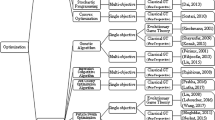Abstract
We extend the single-crossing property to tree networks to facilitate its application in network games. It is equivalent to intermediate preferences and order restriction (also extended to networks). Moreover, to facilitate broader applications in real world cases and simulations, we develop algorithms that answer the following two questions. Given a preference profile, can we construct a tree graph that supports single-crossing? Given a set of alternatives, can we generate single-crossing preference profiles with associated tree graphs?



Similar content being viewed by others
Notes
Let \(>\) be a linear order on the set \(N\) of individuals. Preference profile \(\succeq \) satisfies single-crossing on linear order \(>\), if there is a linear order \(>_{X}\) on \(X\) such that for any pair \( x,y\in X\) with \(x>_{X}y\) and for all \(i, j\in N\) with \(i>j\), we have \(x\succeq _{i}y\) implies \(x\succeq _{j}y\) and \(x\succ _{i}y\) implies \(x\succ _{j}y\) . Preference profile \(\succeq \) is intermediate on linear order \(>\), if for any pair \(x, y\in X\) for all \(i, j, k\in N\) with \(i<j<k\), (i) [\(x\succ _{i}y\) and \(x\succ _{k}y\)] implies \(x\succ _{j}y\), and (ii) [\(x\succeq _{i}y \) and \(x\succeq _{k}y\)] implies \(x\succeq _{j}y\). Preference profile \(\succeq \) satisfies order restriction on linear order \(>\), if for any pair \(x,y\in X\), either \(\left\{ i\mid x\succ _{i}y\right\} >\left\{ i\mid x\sim _{i}y\right\} >\left\{ i\mid y\succ _{i}x\right\} \), or \(\left\{ i\mid x\succ _{i}y\right\} <\left\{ i\mid x\sim _{i}y\right\} <\left\{ i\mid y\succ _{i}x\right\} \).
Saporiti and Tohmé (2006) use a version of single-crossing where the alternatives are real numbers, hence have a preexisting order over individuals.
After the following modification on top-monotonicity, Theorem 1 of Barberà and Moreno (2011) generalizes to tree graphs immediately: Preference profile \(\succeq \) is top—monotonic on \(G\), if for any \(i,j\in G\), there is a linear order \(>_{X}\) on \(X\), such that (i) \(t_{i}\left( A\right) \) is a finite union of closed intervals for all \(i\in p\left( ij\right) \), and (ii) For all \(S\in A\left( \succeq \right) \), for all \(m,n\in p\left( ij\right) \), all \(x\in t_{m}\left( S\right) \), all \(y\in t_{n}\left( S\right) \), and any \(z\in S\), we have \(\left[ x>_{X}y>_{X}z\ \text {or}\ z>_{X}y>_{X}x\right] \) implies (a) \(y\succeq _{m}z\ \)if \(z\in t_{m}\left( S\right) \cup t_{n}\left( S\right) \), and (b) \(y\succ _{m}z\) if \( z\not \in t_{m}\left( S\right) \cup t_{n}\left( S\right) \).
Donder (2013) examines single-crossing satisfied separately inside each among many voter groups. His space of alternatives is, however, a common real interval, thus implies a common order. On the other hand, the order of alternatives in our model is not predetermined and can differ for each chosen path of individuals.
Demange (1994) uses this property as the definition of intermediate preferences.
References
Barberà S, Moreno B (2011) Top monotonicity: a common root for single peakedness, single-crossing and the median voter result. Games Econ Behav 73:345–359
Demange G (1994) Intermediate preferences and stable coalition structures. J Math Econ 23:45–58
De Donder P (2013) Majority voting and the single-crossing property when voters belong to separate groups. Econ Lett 118:523–525
Ellickson B (1979) Competitive equilibrium with local public goods. J Econ Theory 21:46–61
Epple D, Filimon R, Romer T (1984) Equilibrium among local jurisdictions: toward an integrated treatment of voting and residential choice. J Public Econ 24:281–308
Epple D, Romer T (1992) Mobility and redistribution. J Political Econ 99:828–857
Epple D, Romano R, Sieg H (2006) Admission, tuition, and financial aid policies in the market for higher education. Econometrica 74:885–928
Gans JS, Smart M (1996) Majority voting with single-crossing preferences. J Public Econ 59:219–237
Grandmont J-M (1978) Intermediate preferences and the majority rule. Econometrica 46:317–350
Greenberg J, Weber S (1986) Strong tiebout equilibrium under restricted preference domain. J Econ Theory 38:101–117
Jackson MO, Watts A (2002) On the formation of interaction networks in social coordination games. Games Econ Behav 41:265–291
Jackson MO, Wolinsky A (1996) A strategic model of social and economic networks. J Econ Theory 71:44–74
Konishi H, Le Breton M, Weber S (1997) Pure strategy nash equilibrium in a group formation game with externalities. Games Econ Behav 21:161–182
Konishi H, Le Breton M, Weber S (1998) Equilibrium in a finite local public goods economy. J Econ Theory 79:224–244
Kung F-C (2006) An algorithm for stable and equitable coalition structures with public goods. J Public Econ Theory 8:345–355
Kung F-C (2010) Coalition formation with local public goods and group-size effect. Int J Game Theory 39:573–583
Le Breton M, Owen G, Weber S (1992) Strongly balanced cooperative games. Int J Game Theory 20:419–427
Quah JK-H, Strulovici B (2012) Aggregating the single-crossing property. Econometrica 80:2333–2348
Roberts K (1977) Voting over income tax schedules. J Public Econ 8:329–340
Rothstein P (1990) Order restricted preferences and the majority rule. Soc Choice Welf 7:331–342
Saporiti A, Tohmé F (2006) Single-crossing, strategic voting and the median choice rule. Soc Choice Welf 26:363–383
Saporiti A (2009) Strategy-proofness and single-crossing. Theor Econ 4:127–163
Author information
Authors and Affiliations
Corresponding author
Rights and permissions
About this article
Cite this article
Kung, FC. Sorting out single-crossing preferences on networks. Soc Choice Welf 44, 663–672 (2015). https://doi.org/10.1007/s00355-014-0852-5
Received:
Accepted:
Published:
Issue Date:
DOI: https://doi.org/10.1007/s00355-014-0852-5




